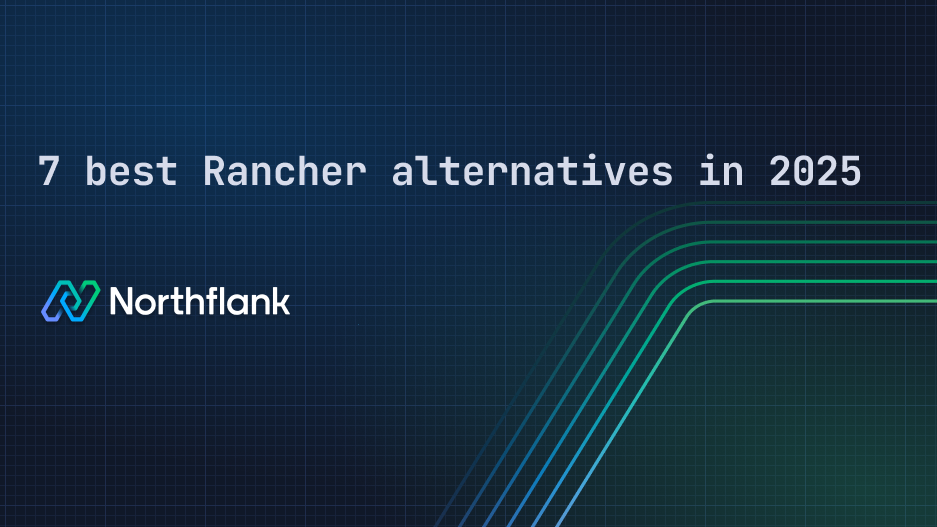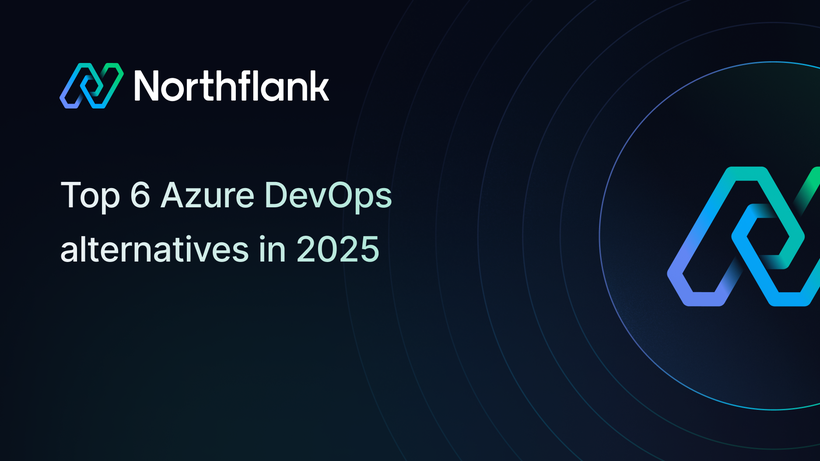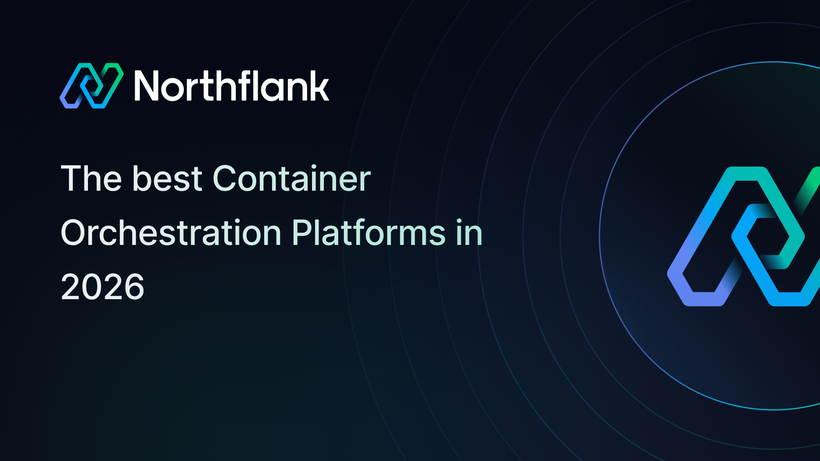

7 Best Rancher alternatives in 2025
For years, Rancher has been a go-to for managing Kubernetes at scale—especially in ops-heavy, enterprise environments. But not every team needs that level of complexity. As Kubernetes becomes more of a baseline than a badge of honor, developers are rethinking the tools they use to work with it.
If you’re spending more time wiring up infrastructure than building your product, it might be time to look at alternatives.
In this article, you’ll find seven Rancher alternatives worth considering in 2025, and learn what makes each one a better fit for different kinds of teams.
Just want the list? Here are 7 Rancher alternatives developers are turning to in 2025:
- Northflank – Dev-first Kubernetes platform with built-in CI/CD, databases, preview environments, and Git-based workflows.
- Portainer – Simple UI for managing containers and clusters, with minimal resource requirements.
- OpenShift – Full-stack enterprise Kubernetes with strong RBAC and security.
- Platform9 – SaaS-managed Kubernetes with a focus on hybrid, edge, and on-prem environments.
- KubeSphere – Open-source Kubernetes platform with a modular architecture and DevOps tools built-in.
- Mirantis Kubernetes Engine (MKE) – Docker Enterprise’s spiritual successor, with enterprise-grade orchestration and governance.
- Giant Swarm – Fully managed multi-cluster Kubernetes targeting mid-sized and enterprise teams.
Rancher earned its reputation as an open-source powerhouse for multi-cluster Kubernetes management. For platform teams and enterprises running dozens of clusters across clouds or on-prem, it's a strong fit. But for many developer-centric teams—especially those not looking to build a full platform internally—Rancher can feel like more tooling than necessary.
Common developer pain points with Rancher include:
- Requires significant Kubernetes expertise to set up and operate effectively.
- Designed more for ops teams than dev teams.
- Lacks built-in features like CI/CD, managed databases, or preview environments, so teams end up integrating multiple tools manually.
- Can feel bloated or overkill for simpler use cases or smaller projects.
If you're spending more time managing the platform than building on it, it might be time to consider a more modern alternative.
Not every team needs to run dozens of Kubernetes clusters. In fact, many just need a platform that abstracts complexity, handles infrastructure automatically, and lets developers ship confidently without YAML deep-dives.
Here’s what to look for:
- Developer-first workflows – Git-driven deployments, automatic builds, preview environments, and one-click rollbacks.
- Built-in services – Managed databases, cron jobs, workers, and queues—no extra plugins required.
- Integrated CI/CD – Don’t bolt it on. The platform should include CI pipelines, container builds, and deployments natively.
- Sane defaults – Secure by default, with HTTPS, secrets management, and sensible RBAC(Role-Based Access Control).
- Observability baked in – Logs, metrics, and alerts should be first-class—not an afterthought.
- Fast feedback loops – Reduce the time between writing code and seeing it live.
Looking for a simpler way to run Kubernetes? These alternatives to Rancher are making waves in 2025, each offering a fresh take on how teams build, deploy, and scale with less overhead.
Northflank is what Rancher wants to be for developers. It gives you all the power of Kubernetes—container orchestration, service discovery, and autoscaling—but wraps it in a developer-first experience.
No need to manage YAML files by hand. With Git-integrated workflows, built-in CI, automatic SSL, and managed databases, Northflank helps you go from code to running service in minutes. It also handles the heavy lifting like horizontal scaling, persistent storage, and background workers with a clean, intuitive UI and APIs.

Key features:
- Kubernetes-powered, full-stack platform
- Deploy containers, databases, and scheduled jobs
- Bring your own cloud (AWS, GCP, Azure, etc.)
- CI/CD integration, real-time logs, with a developer-friendly and consistent experience across UI, CLI, API, and GitOps
- GPU support for AI workloads
- Automatic preview environments and seamless promotion to dev, staging, and production
Best for:
- Dev teams building APIs, microservices, and containerized web apps
- SaaS products needing multi-service architectures
- Teams looking for a fast, clean alternative to older, more rigid platforms like Rancher
Potential drawbacks:
- Highly experienced DevOps teams might find it restrictive compared to directly managing raw Kubernetes clusters. It’s a fine balance between ease of use, flexibility, and customization; that line differs for every organization.
- Less established compared to legacy platforms like Rancher.
See how Weights company uses Northflank to scale to millions of users without a DevOps team
Portainer is a lightweight container management UI for Docker and Kubernetes environments. It’s not a full-fledged platform like others here, but it offers a user-friendly way to manage container infrastructure visually.

Key features:
- Simple dashboard for managing containers and clusters.
- Works with both Docker and Kubernetes.
- Role-based access control and team management.
- Minimal resource requirements.
Best for:
Self-hosters and small teams that want a visual layer over their existing container infrastructure.
Potential drawbacks:
- Lacks deeper DevOps features like CI/CD or GitOps.
- Not intended for large-scale enterprise workloads.
OpenShift is a comprehensive Kubernetes platform developed by Red Hat. It’s designed for hybrid and multi-cloud deployments, offering strong security, compliance features, and enterprise support.

Key features:
- Full-stack Kubernetes with integrated developer tools.
- Native CI/CD with Tekton and support for pipelines.
- Robust RBAC, policy enforcement, and compliance capabilities.
- Deep integration with Red Hat Linux and other enterprise tools.
Best for:
Large enterprises already invested in Red Hat infrastructure or needing high-security, compliance-ready Kubernetes environments.
Potential drawbacks:
- Complex to set up and maintain without dedicated platform teams.
- Can be resource-intensive and expensive.
Platform9 is a managed Kubernetes solution designed for on-premises, edge, and hybrid cloud environments. Unlike fully cloud-hosted Kubernetes services, Platform9 allows organizations to run Kubernetes anywhere while benefiting from a SaaS-based management model.

Key features:
- Fully managed Kubernetes with a 99.9% uptime SLA.
- Works across on-prem, hybrid, and edge environments.
- Zero-touch upgrades and automated operations.
- Open-source foundation with no vendor lock-in.
Potential drawbacks:
- Smaller market share compared to OpenShift, which may affect long-term support.
- Reliance on a SaaS-based model may not be suitable for some enterprises.
KubeSphere is an open-source layer on top of Kubernetes that adds a dashboard and a suite of DevOps tools. It’s modular and flexible, especially for teams that already run their own clusters and want to gradually enhance them with UI and automation.

Key features:
- Visual interface for Kubernetes resource management
- Built-in support for CI/CD, observability, and multi-tenancy
- Pluggable architecture: enable only what you need
- Self-hosted and fully open-source
Best for:
- Teams already managing their own clusters
- Organizations comfortable maintaining infrastructure but wanting better UX
Potential drawbacks:
- Still requires ops knowledge to run and scale effectively
- UI is improving, but the overall experience can feel fragmented
- Lacks the end-to-end polish of a fully integrated platform.
Mirantis Kubernetes Engine (formerly Docker Enterprise) is a governance-heavy platform designed for ops teams managing secure, large-scale deployments. It supports Kubernetes and Docker Swarm, which makes it good for legacy environments—but it’s not designed for fast-moving dev teams.

Key features:
- Secure container orchestration with strong compliance tooling
- RBAC, image scanning, and LDAP integration
- Hybrid support for Kubernetes and Swarm
- Enterprise support and SLAs
Best for:
- Organizations with strict compliance needs and legacy systems
- Large ops teams that need tight infrastructure control
Potential drawbacks:
- Dev teams may find it slow and heavy to work with
- Not developer-first; built around ops workflows and governance
- More complexity than many modern teams need
Giant Swarm offers white-glove Kubernetes management for companies running dozens or even hundreds of clusters. It’s tailored for enterprises that want Kubernetes benefits without handling the infrastructure themselves—but it comes with enterprise-level complexity (and pricing).

Key features:
- Multi-cluster and multi-cloud management
- GitOps-native deployments
- Hands-on engineering support
- Pre-integrated observability and compliance tools
Best for:
- Large orgs with complex Kubernetes footprints
- Teams looking for long-term platform engineering support
Potential drawbacks:
- Expensive and tailored for large-scale needs
- Not designed for fast-moving product teams or startups
- Less flexibility for smaller teams or projects
Choosing a Rancher alternative isn’t just about features—it’s about fit.
Ask yourself:
Are you building a platform or building a product?
If your team wants to own every layer of the stack, tweak every RBAC policy, and manage clusters across environments—something like OpenShift or Mirantis might make sense.
But if you’re a startup, SaaS team, or modern dev org that just wants to ship faster without spending cycles gluing tools together, it’s time to look beyond traditional platforms.
Here’s how to narrow it down:
- Want to skip YAML and ship from Git? Look for platforms with native GitOps and CI/CD baked in.
- Need managed databases, background workers, or preview environments out of the box? Choose tools that treat those as first-class, not plugins.
- Working with a lean team, or no dedicated DevOps? Prioritize simplicity, automation, and sane defaults.
- Care about developer experience? You shouldn’t need a PhD in Kubernetes to deploy your API.
That’s where a tool like Northflank stands out. It gives developers what they actually need: containers, builds, databases, environments—all wired up, scalable, and ready to go.
Kubernetes is no longer the exclusive domain of platform engineers and enterprise ops teams. Developers today want tools that let them deploy fast, scale with confidence, and stay focused on building—not wiring up infrastructure.
Rancher paved the way for Kubernetes at scale, but it was built for a different era—and a different audience.
If you're tired of YAML overload, pipeline patchwork, or managing three tools just to ship a feature, it's time to rethink what your platform should do for you.
Northflank gives you the power of Kubernetes without the complexity. Built-in CI/CD, preview environments, managed databases, and a clean Git-based workflow—no DevOps team required.
🚀 Ready to ship faster with fewer headaches? Try Northflank for free →



